 |
UK Decay
UK DECAY COMMUNITIES 2008
|
| View previous topic :: View next topic |
| Author |
Message |
werewolf
Site Admin

Joined: 03 Feb 2004
Posts: 1240
Location: Luton UK
|
 Posted: Sun Jul 04, 2004 4:00 am Post subject: City of Ravens Posted: Sun Jul 04, 2004 4:00 am Post subject: City of Ravens |
 |
|
City of the Ravens
If Los Angeles means 'City of the Angels' then Ravensburgh means 'City of the Ravens'.
Situated on the Beds/Herts UK, borderlands some 5 miles North East of Luton above Hexton on the Chiltern hill Escarpment lays Eastern Britains largest Hillfort.
| Quote: | | Hexton stands north east of Luton in well-wooded and hilly country adjacent to the Bedfordshire border. The church is mediaeval with heavy 19th century restoration. Far older is the Iron Age camp of Ravensburgh Castle that straddles the hilltop. Built about 400BC and refortified in IBC, it has two entrances, covers 22 acres, and is surrounded by a ditch. |
Following the 'return to Clophill Church' and with a 'thirsty' appetite for
more intrigue into the mystical landscapes and 'Occult' village pubs, the
'Barton Warlocks' set out on an expedition to find this 'mythical' City of the Ravens.
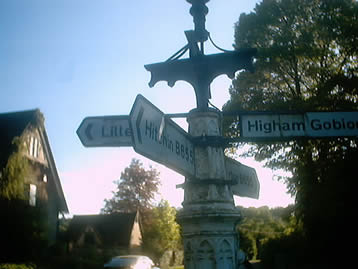
After meeting outside the Church in Hexton the 'Warlocks' gathered their
divining staffs and offerings and got ready to embark on the journey into
forbidden territory. Looking at the Medieval Church (of St. Faith)
they noticed that one whole side of the Church Tower had collapsed
recently although the Church was still in use! Could this church be
going the same way as Clophill Church , approximately 5 miles to the north?
One barton warlock told us about the 'Witch of Hexton'..'Old Meg'..who
got burnt at the stake and now a spring is named after her nearby.
One things for sure, even though there is a busy road going through
the village, you could easily imagine that you have been 'transported'
back in time. With the church and some of its cottages, small village
school and incredibly high walls that surround the Manor House
{who are they trying to keep out..or in!)
Hexton has a very unusual 'vibe' about it.very charming on a nice sunny
day. However there are some very odd things about there too!
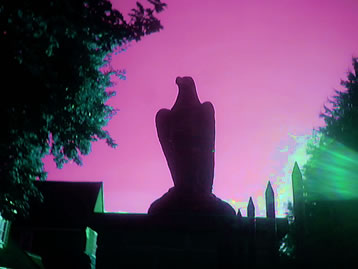
At the gates of the vicarage!
There were 2 'sentinel' Ravens guarding the gates of the vicarage looking
menacing, further up the road they passed the old Police station which has
now been turned into a very desirable dwelling
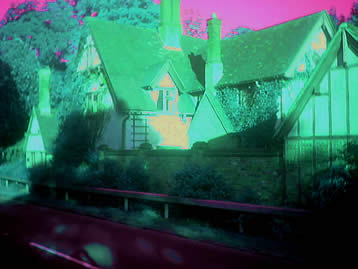
Police station or Witches cottage?
The ancient 'Icknield way' Britain if not Europe’s oldest road travels
on top of the hills surrounding Hexton which are also smothered in ancient
Barrows, dykes and other evidence of Iron Age civilisation. Nearby is a hill called
'Wayting hill' of which local
Folklore tells of a 'sleeping warrior'
Whom one-day will re-awaken and claim
his kingdom.
At the crossroads in the middle of the village the 'Warlocks' noticed that
the village Signpost doubled as a water pump! Could this pump be fed
from the 'Faery Hole' spring?
Deep inside the Ravensburg Castle area there is a wooded-valley with a
spring in its lower reaches. The valley is known as 'Faery Hole' and the spring
is known as 'Burwell spring' . This spring was the castles water source and feeds
a stream which runs further down the valley towards Hexton. From there it was
pumped up by the now de-funct
Water pump.
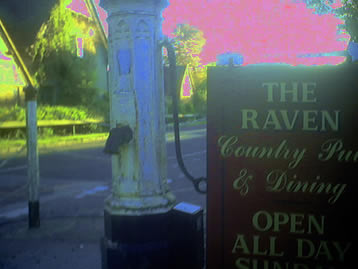
Which way? right for the village pub called 'The Raven' or left for the castle?
The village pub would have to wait the mission was Ravensburg
So the 'Warlocks' made their accent up the hills towards the lonely castle.
The whole area of the castle is privately owned and the general public
is 'prohibited' from enjoying its enlightenment.
The plan was to follow the old 'Green Road' known as the 'Hexton Highway'
which led to Luton, now a footpath that led through part of the
Castle hinterland. At a suitable point they headed of into the wooded-hills and
valleys complex . The further they got into the forest the quieter and darker it got!
Eventually after climbing up steep hills through at times
deep undergrowth, they reached the ramparts of the Castle!
After 2 and a half thousand years all that was left to see was an a
grassed embankment on the north-west corner, which is on the highest
part of the hill. This corner led to a large plateau which descended at 'Barton hills'
on the other side On this corner was said to have been the
main entrance.
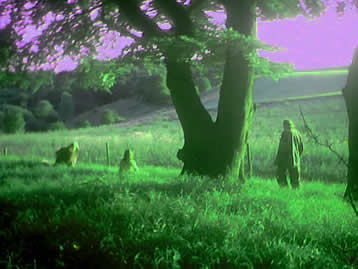
The Warlocks sitting on the grassed bank, now all that is left of the once mighty defence system on the main entrance
The ramparts of the castle follow a roughly rounded rectangular shape,
north to south and apart from the North west corner the ground
falls steeply down to the valley floor. It would have been a formidable obstacle
to have tried to overcome if you were to try and take the castle by force
in the Iron Age. Now its difficult enough to try and get through the
undergrowth!
After a brief rest the party continued around the castle on the top of
the ramparts towards the south east corner where the second entrance
led to the spring. Here they would descend the steep sides of the hill deep
into the valley below towards 'Faery hole' and the 'Burgh well' spring.
Eventually after a few slides and tumbles and breaking through some
extremely thick undergrowth, the warlocks entered the deep
flat-bottomed valley floor which turned out to be a grassed meadow.
Following the valley floor round a bend gave one a sense of what
the castle must have looked like in its hey-day. There would be no trees!
(the current forest, is a plantation that was started in the 1920's!)
The whole area would have been grassed hills and a maze of dry river
valleys that encircled a central hill with was crowned by the massive
castle ramparts and pallistrade’s.
The actual slopes of the castle hill itself were 'lynches' which if you can
imagine, are like steps carved out into the side of the hill, for growing
crops. This place must have been teeming with activity and must have
acted like a major seat of power in its dominating position on the
'Icknield Way'
In fact there is very strong evidence to suggest that Ravensburgh may
have been the site of the oppidum where Caesar defeated the British
warlord Cassivellaunus in 54BC. Having done this he was satisfied
that he held the British nation under his manners and returned to Rome.
[url=http://www.roman-britain.org/places/celtic/ravensburgh_castle.htm]
Ravensburgh.Roman-Britain[/url]
The party now made its way toward the burr well spring at the foot of
'Faery hole' along the flat-bottomed valley floor. They reached a copse of
trees and then descended into a deep wooded pit at the bottom of which
there was a
pool of water.
They had reached the spring, the water source for the ravensburgh
Knights. Right away there was a realisation this was no ordinary spring
the water that was bubbling up from the chalk below had a special quality.
After bathing and 'taking of the waters' the warlocks blessed the 'Holy
spring' with offerings of flowers, said goodbye and departed.
It was a struggle climbing back up the sides of the pit but when they got
back out to the meadow, the silence was broken by a cacophony of Crows
flying above! Quite fitting they were heading back towards the castle
Ramparts!
The party then ascended another valley and found a nice site to eat
their curry
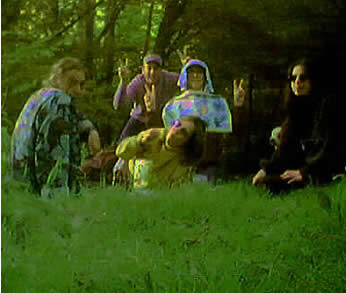
after eating the first ever curry eaten on Ravensburgh castle, the Barton Warlocks chill out!
see what familly castle says about Ravensburgh Castle  
_________________
Visit The new UK Decay Communities
Last edited by werewolf on Sun Aug 22, 2004 11:37 pm; edited 3 times in total |
|
| Back to top |
|
 |
werewolf
Site Admin

Joined: 03 Feb 2004
Posts: 1240
Location: Luton UK
|
 Posted: Tue Jul 06, 2004 2:59 am Post subject: City of the Ravens more on Hexton Church Posted: Tue Jul 06, 2004 2:59 am Post subject: City of the Ravens more on Hexton Church |
 |
|
City of the Ravens more on Hexton Church
As mentioned in the previous post the Church of st.Faiths in Hexton's Tower
had collapsed
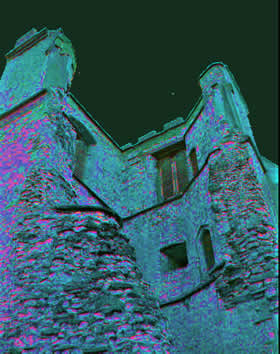
After trawling for a possible reason for this we came across an interesting
article on antipope.org which told of a story about the 'Holy well' of st.Faiths
[url=http://www.antipope.org/feorag/wells/hope/hertfordshire.html]
| HEXTON : ST. FAITH'S WELL. wrote: | | There is a small parcel of ground adjoining the churchyard called "St. Faith's Wick Court," about a pole in measurement, anciently divided from Malewick by a ditch in the same place where now a large moat is made. The greatest part of this Wick lying upon a bed of springs, and undrained, was very boggy towards the churchyard; but the west side being higher, the ground was well planted with oaks, willows, and bushes, near adjoining unto [80] which, writeth a narrow-minded Pharisee, the crafty priests had made a well about a yard deep, and very clear at the bottom, and curbed about, which they called St. Faith's Well. Now over this well they built a house, and in the house they placed the image and statue of St. Faith, and a causy they had mad (which I found when I digged and levelled the ground) for the people to pass who resorted thither from far and Hear to visit our Lady, and to perform their devotions reverently, kissing a fine-coloured stone placed in her toe. This Lady was trimly apparelled, and I find in an old book of churchwarden's accounts, in the reign of Henry VIII., that they had delivered unto the St. Faith a cote and a velvet tippet. The Lady had no land to maintain her, that I know of, more than 1 acre lying in Mill Field, called at this day St. Faith's ½ acre, which, as being given to superstitious uses, came to the King's hands at the dissolution, and is now parcel of the demesnes. The house being pulled down, and the idol cast away, the well was filled up, yet an apparent mention of the place remained till my time, and St. Faith's Well continued as a waste and unprofitable and neglected piece of land till such time as the footpath was turned through the midst of it to the outside on the south by the highway, and their clearing and levelling the ground, having been drained, and sunk the spring, I converted the same, in the year of our Lord 1624, into a little orchard. The Lady Faith was a Virgin and Martyr of Agenne, in France, A.D. 1290. --MS. account of Hexton, by Francis Taverner. Her feast-day in the Calendar of Saints is October 6. |
See the article at source[/url]
Judging from this we must presume the Tower collapsed because it was
near to the original well, which is now a moat ( only 10 metres to the
west) Obviously the whole area is riddled with underground waterways
and although the Church had been built in the 12th century and had survived intact
for 8 hundred years, the unstable ground had eventually
given way causing the Tower to collapse.
[url=http://www.hertfordshire-genealogy.co.uk/data/books/book0131-hexton.htm]
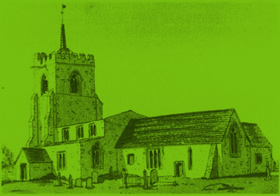
For further information on the area check out this book[/url]
Now, with the 'Holy' springs of 'Burwell', 'Meg' and Barton nearby and
bearing in mind the odd waterpump at the crossroads of the village,
this leads us to think of the ancient origins of the area and its
associations with Holy Wells, Springs and underground waterways.
The fact that the Icknield way runs along the Chiltern escarpment and
is never far away from the series of springs that errupt out of the
foot of the hills fits in with the ancient Celtic Watercult theories.
Check out this article for further information
Its interesting to note that some 5 miles south west at a place now called
'5-Springs' at Wauluds Bank{a Henge- Monument}, the Celtic god 'Lug'
or 'Lud' or 'Lyg', presided over the springs that are the source of the River Lea.
'Lud' is the Celtic God of light, and indeed the name 'Lea' or 'Lee' is a corruption of this
name...the town now known as Luton is named after this river which
in itself is named after the god of light! 'Ton' is an Anglo Saxon name for
a town or large settlement
So therefore Luton means " the town of Lud' -the Celtic God of Light'!
Does this sound like the Luton you know?
 
_________________
Visit The new UK Decay Communities
Last edited by werewolf on Sun Aug 22, 2004 11:41 pm; edited 1 time in total |
|
| Back to top |
|
 |
PJ
King of Chav's

Joined: 04 Apr 2004
Posts: 148
|
 Posted: Thu Jul 08, 2004 4:50 pm Post subject: Posted: Thu Jul 08, 2004 4:50 pm Post subject: |
 |
|
| Interesting stuff, the word lee also means light in celtic and was used to discribe ley lines which seem to join up old churches,springs,crossroads, and often i have found scots pine trees marking the way of ley lines when dowsing. I wonder if anyone has infomation on meg the witch that lives in Hexton and collected her magic herbs by the fairey hole spring and surrounding woodlands, It seems strange to me that this historic site and holy spring have been hidden away?, maybe the planting of the trees over ravensburg and and spring was to create local work but now it hides the ancient capital of England I guess if ceasar hadnt captured casavalanius then london wouldnt be the capital but ravensburg would . There is an old story from the romans that caseveanius could hide his army in a invisible cloak and would attack the romans down the lea valley through marsh and forest only to disapear again without trace back to their secret hill fort at ravensburg it took romans a long time to find them. If you ever see a strange fog or cloud at ground level moving around the place be aware you are being watched by the gardians of ravensburg castle. |
|
| Back to top |
|
 |
werewolf
Site Admin

Joined: 03 Feb 2004
Posts: 1240
Location: Luton UK
|
 Posted: Sat Sep 04, 2004 2:13 am Post subject: More on Wayting Hill Posted: Sat Sep 04, 2004 2:13 am Post subject: More on Wayting Hill |
 |
|
More on Wayting Hill
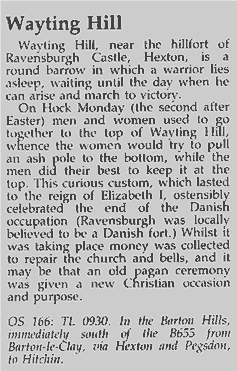
Scanned from a book called 'Gothick Hertfordshire' by Jennifer Westwood
Shire Publications isbn 0 7478 0041 3
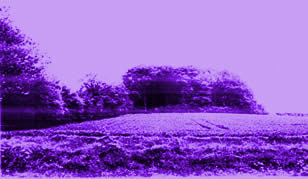
Fascinating reading this book, Gothic tales from one of the deepest Shires
Hertfordshire, UK. complete with lots of echoes of the Pagan past
The sleeping warrior legend is synonymous of course with the King Arthur
legends of the once and future king who one day will rise again and claim
the throne. These legends can be found at various places in the British Isles
and had an effect of the minds of the medieval kings of this land!
Henry V111 would never had happened, had his older brother 'Arthur'
not had the misfortune of dying. 'Arthur' was to be king in his fathers
(Henry V11) eyes. Henry V11 believed that he was decended from the original
King Arthur. So after bashing up the last of the 'Norman' king bloodline
at the battle of Bosworth in the 'war of the roses' Henry married
Elizabeth of York and had a son.
Such was Henry's beleif that one day Arthur would arrise and retake the
throne, he would make sure of it by naming his son, heir to the English
throne Arthur. That would make sure the legend would come true!
Sadly that was not to be, 'Arthur' died barely a teenager leaving the
throne to his next brother who would become Henry V111.
The Danish connection
Also mentioned in the Wayting hill peice above is that the locals believed
that the Hillfort was a Danish (Viking) castle.
This may have some basis of truth for in William Austins seminal 'The
History of Luton and its Hamlets', it is mentioned that in the time of
'Danelaw' AD800/900 when this whole area was a frontier, there was a
terrific battle between the 'brave and worthy men of Luton' and the
vikings who perhaps were based at Ravensburgh castle. The Battle took
place somewhere behind Warden Hills (now north Luton) and was won by
the Saxon Lutonians.
So was Ravensburgh a Viking fort?
Maybe, because of its great strategic position stradling one of the 4 great
roads of England according to Edward the Confesser, the Icknield Way.
Also the 'Danelaw Frontier' followed the river Lea from the Thames to
its source at Leagrave, then north to Bedford. Yes it doesnt take any
'nerd' with a map to work out what a good forward position to the
vikings this position would be! Furthermore, the Iron age Fort would
have been in a much less deteriated condition and easilly adaptable
to their needs of a camp.
Their is no doubt that Ravensburgh is of Iron Age origin, see James
Dyers 'Hillforts of England and Wales'. But it is now becoming
widely accepted that 'Ravensburgh' was indeed the Opidium where
Julius Caeser defeated the British warlord Cassivellaunus in 54BC!
So if the Danes (vikings) used Ravensburgh they did so because it
was already a set up in a well established strategically important location.
#
Having walked the whole northern Chiltern area particularly the Barton
hill range, it is patently obvious that although now arguably a backwater,
that this area must have been a lot more important in the past. The
hilltops in the whole area are absolutely moulded and shaped by past
peoples fortifications and sacred burial sites.
All that is left off the past great civilisations that carved out these hills,
is the impressions in the ground and the distant echoes of Folklore,
there is little written. But as you walk over the rounded and sometimes
forested chalk hills, its not dificult to gain a feeling of 'connectedness'
with the past.
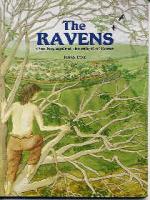
Book castle...'The Ravens'
Although for Kids,, this book is a must read if you want more on
Ravensburgh castle. Written by James Dyer who is one of the areas
leading archaeologists although fiction and aimed at kids, provides the
reader with some profound insights into the life and times of Ravensburgh
and Caesers attack!
 
_________________
Visit The new UK Decay Communities
|
|
| Back to top |
|
 |
the Poacher
Joined: 16 May 2005
Posts: 6
|
 Posted: Mon May 16, 2005 11:39 pm Post subject: Cassivelaunus Posted: Mon May 16, 2005 11:39 pm Post subject: Cassivelaunus |
 |
|
Cassivelaunus, a British chieftain, ruler of the country north of the Thames, who led the native tribes against Julius Caesar on his second expedition in 54 BC. After several indecisive engagements, Caesar took the camp of Cassivelaunus, who was obliged to make peace on condition of paying tribute and giving hostages. But these promises were not meant to be kept, and it appears certain that the tribute was never paid. According to Bede's Ecclesiastical History, the remains of Cassivelaunus's entrenchment were visible seven or eight centuries later, even today. He appears in Julius Caesar's De Bello Gallico, having been given command of the combined British forces opposing Caesar's second invasion of Britain. Caesar does not mention Cassivellaunus's tribe, but his territory, north of the river Thames, corresponds with that later inhabited by the Catuvellauni.his Father: King Heli
is mentioned in the bible Heli the Father of Joseph and the father of Cassivelaunus .HELI was both judge and high-priest, whose history is related in I Kings, i-iv. He lived at Silso, where the ark of the Lord was kept at that time. Lud son of Heli was a legendary king of the Britons as accounted by Geoffrey of Monmouth his home now know as wuluds bank in Luton. He had two sons, Androgeus and Tenvantius, neither of whom succeeded him directly. Lud died and was buried in Trinovantum near a gateway named Ludgate (Porthlud in Welsh). He was succeeded by his brother Cassivelaunus, who acted as regent for Androgeus. Cassivelaunus lived at his secret hill fort now now as ravensburg castle.
In Geoffrey of Monmouth's Historia Regum Britanniae (History of the Kings of Britain), Cassivellaunus was the son of King Heli and regent for his nephew Androgeus, the son of King Lud.
Soon after Lud's death, Cassivelaunus was crowned king in favor of his two young nephews whom he had been serving for as regent. He gave to his elder nephew the duchy of Kent and Trinovantum (London), and gave to his younger nephew, Tenvantius, the duchy of Cornwall.
Sometime in the beginning of his reign, Julius Caesar requested the British to pay tribute to Rome as a means of avoiding warfare between the two kingdoms which claim descent from the Trojans. Cassivelaunus refused the offer and Caesar invaded the country along the banks of the River Thamesis. After much fighting, Nennius, Cassivelaunus's brother, stole Caesar's sword and led the army of the Britons successfully against the Romans. They pushed the Romans back to their ships where they fled to Gaul and brooded over their loss.
The Romans waited two years until they returned to Britain. Cassivelaunus rebuilt city walls and defences throughout Britain while awaiting Caesar's attack. Most famously, he commanded that large spikes be placed in the water beneith the Thames so that the bottom of the Roman ships would be gutted as they floated down the river. Mass conscription went out among the Britons and barracks were constructed all along the river.
Around 54 BC, the Romans finally invaded again and were devestated in the river and along the shores of the River Thames. After numerous charges, the Romans were defeated and forced off Britain once again. Cassivelaunus celebrated the victory with massive sacrificing of animals in London.
It was at this celebration that Androgeus and Cassivelaunus fought over the death of a relative. Cassivelaunus became angry and ravaged the lands of Androgeus causing Androgeus to seek the aid of Caesar. Caesar invaded for a third time and occupied London due to the help of Androgeus. Cassivelaunus counterattacked but was not able to defeat Caesar so he fled to a hill near hexton and held his ground. After lots of battles cassivelaunus started using gurilla tactics and lured the romans into the dominions of cassivelaunus. ceasar managed with difficulty to cross the thames river though its passage had been rendered almost impossible to cross by artifical means, once across he continued to be much harrassed by the sallies of the britons from their forests. The Trinobantes, however, with whom cassivelaunus had been at war, and some other tribes submitted to the Romans. Through them Ceasar became acquainted with the site of the capital of cassivelaunus which was some thirty or forty miles north of London and surrounded by forests and marshes.Ceasar forthwith made an attack upon ravensburg and took it but cassivelaunus escaped using a cloak of invisiblity.
_________________
The plowman he feeds us all except me i catch me own. |
|
| Back to top |
|
 |
Guest
|
 Posted: Tue May 17, 2005 12:09 am Post subject: is this the place jusus talked aboout? Posted: Tue May 17, 2005 12:09 am Post subject: is this the place jusus talked aboout? |
 |
|
| Heli (Gr. HELEI--Luke 3:23) is evidently the same name as the preceding. In Luke he is said to be the father of Joseph, while in Matt., I, 16, Jacob was Joseph's father. The most probable explanation of this seeming contradiction is afforded by having recourse to the levirate law among the Jews, which prescribes that when a man dies childless his widow "shall not marry to another; but his brother shall take her, and raise up seed for his brother" (Deut., xxv, 5). The child, therefore, of the second marriage is legally the child of the first (Deut., xxv, 6). Heli having died childless, his widow became the wife of his brother Jacob, and Joseph was the offspring of the marriage, by nature the son of Jacob, but legally the son of Heli. It is likely that Matt. gives the natural, and Luke the legal descent. (Cf. Maas, "The Gosp. acc. to S. Matt.", i, 16.) Lord A. Hervey, Bishop of Bath and Wells, who wrote a learned work on the "Genealogies of Our Lord Jesus Christ", thinks that Mary was the daughter of Jacob, and Joseph was the son of Jacob's brother, Heli. Mary and Joseph were therefore first cousins, and both of the house of David. Jacob, the elder, having died without male issue, transmitted his rights and privileges to the male issue of his brother Heli, Joseph, who according to genealogical usage was his descendant |
|
| Back to top |
|
 |
donuts
Guest
|
 Posted: Tue May 17, 2005 11:11 pm Post subject: poaching Posted: Tue May 17, 2005 11:11 pm Post subject: poaching |
 |
|
| vrily, thou talkest bollocks of the highest degree. |
|
| Back to top |
|
 |
werewolf
Site Admin

Joined: 03 Feb 2004
Posts: 1240
Location: Luton UK
|
 Posted: Thu May 19, 2005 12:00 am Post subject: Hocktide:: more on Ravensburgh Posted: Thu May 19, 2005 12:00 am Post subject: Hocktide:: more on Ravensburgh |
 |
|
Hocktide:: more on Ravensburgh
The five or so square miles of the Hexton and the Hexton Hills range
includes place names such as
Wayting Hill, Bonfire Knolls, Ravensburgh Castle (Hillfort),
Fairy Hole, Burr Well, Butts Hill, Deacon Hil, Knocking Knoll Barrow,
St. Faith's Well, The Meg, Lion hill, Noone Hill, and Hexton
The very names of these places give clues to this areas ancient
legacy! They are positively dripping in history and mystery.
In earlier articles we discussed the possible historical
connections with Julius Caeser and the Romans, Cassivelaunus, the
ancient British King, the Celtic Water Cults, St. Faith's Well and the
holy pilgrimage's, the Viking connection, the Ickneild way etc
I might also take this oppurtunity to mention that another fact has
recently come to point. Although established in Saxon times Hexton the
village as seen today, was designed as a 'Model' village in the 1920/30's
along the same lines as the nearby larger Welwyn Garden City and
Letchworth Garden Cities were.
'The Hocking'
But we were really fascinated to learn more about the celebrated
‘Hocktide’ Festivals that took place there. We had gained a colourful
insight in James Dyers Kids book ‘The Ravens’ where after drinking
of the ‘Hock’ ale the young men and women marched up the hill and
played tug of war with a large pole, usually ending in a romp of laughter
and merriment. (‘The Hocking’)
Although the account states the origin of this festival in Hexton could
be attributed to the Danes it is known that the Hocktide festival (a week
or so after Easter) probably go back to at least Celtic times.
Please note:
The following account’s source was found on the internet but
unfortunately we have lost the link, the link will be forwarded when
it is found.
'Hocktide'
"A Mr Frances Tavener, of the neighbouring village of Hexton, lying almost
at the foot of the Danish fort ‘Ravensboro,’ says of the Hocktide festivities
about the year 1649 :
‘I am certain that in this place the Danish yoke lay heavy upon the
people, and in the memory of persons living in the year 1600 the Hocktide
feast was yearly solemnised by the best inhabitants, both men and
women, in the fields and streets of Hexton with curious pastimes and
jollities.
Before every Hock-day the people elected two officers called the hockers,
a man and a woman, whose office it was to provide the hock-ale and to
provide and order the feast for that year. These hockers had each a large
birchen broom, and on Hock-Monday many of the most substantial of the
people – boys and girls were not admitted to participation in either the
sports or the feast – went together to the top of Wayting Hill, the highest
hill in the parish.
On the top of Wayting Hill was a barrow or ancient grave, and upon the
top of the barrow was fixed a strong ash-pole. The pole was attacked by
the women and defended by the men. The women would be allowed to
seize the pole, and then the struggle commenced, the women striving to
bring the pole down the hill while the men strove to retain it, but, by
reason of the steepness of the hill, the women would always succeed in
hauling the pole to the foot of the hill.
Sometimes the men most ungallantly would let the pole go so suddenly
that the women fell over and over, to the great amusement of every one.
When the women had succeeded in bringing the pole to the level ground
the hockers laid lustily about them with their brooms, and the women
would thrust the men into ditches and into the brook. Thus they strove
and laboured incessantly for two or three hours, not ceasing until they had
brought the pole into the town and set it up at the Cross by the Town
House door.
The people then sat down to a great feast in the Town House, and after
they had feasted the hockers gathered money of every one, part of which
was appropriated for the poor and the rest for the repair of the church.
The accounts of the Churchwardens showed that the sum given to the
Churchwardens was about twenty shillings sometimes more, sometimes
less.
In the afternoon the people adjourned to the play-close, where, among
other sports, the women played baseball against the men, and if they took
any man prisoner ‘they would use him unhappily enough.’ The writer, Mr
Tavener, remarks, ‘I think these nicer times of ours would not only
despise these sports but account them immodest, but those plain and
well-meaning people did solace themselves in this manner, and that
without offence or scandal.’
The generally accepted theory of the origin of the Hocktide festivities is
that it was designed to commemorate the conquest of England by the
Danes. It is difficult to find any connection between the struggle of the
sexes for the possession of a definite object and any triumph over the
Danes or over the Saxons. What did the pole symbolise – for a symbol it
surely was – and its erection upon the highest point in the district?
It would seem to typify power or sovereignty, and its uprooting,
deposition. But why should its downfall be caused by the weaker sex? The
whole performance is perplexing, but that it had reference to some
historic or prehistoric occurrence one cannot well doubt."
Further reading on 'Hocktide'
 
_________________
Visit The new UK Decay Communities
Last edited by werewolf on Mon Jun 27, 2011 6:24 pm; edited 1 time in total |
|
| Back to top |
|
 |
Guest
|
 Posted: Thu May 19, 2005 2:08 pm Post subject: lingum worrship phallus Posted: Thu May 19, 2005 2:08 pm Post subject: lingum worrship phallus |
 |
|
| I think this had a lot to do with Anglo-Saxon King Hardicanut who died in 1042, this was a good excuse for a gang bang and the women instigated it. King Hardicanut was a wild man that loved to foricate and follow the ways of the celtics as he was a collecter of their arts. It was a good way to create harmony in a village and dispell any bad feels or anger. Origanally it came from the celtic people long before the anglo saxons the celtic woman would chase the men down the hill the men would be naked only painted in wuod or red earth and the woman would catch them by their manhood,o once captured the woman could claim the man as her husband and much shagging would follow these sex magik rituals which worshipped the lingum.(phallus) |
|
| Back to top |
|
 |
PJ
King of Chav's

Joined: 04 Apr 2004
Posts: 148
|
 Posted: Thu May 19, 2005 2:37 pm Post subject: Posted: Thu May 19, 2005 2:37 pm Post subject: |
 |
|
The Tithing Men set off with their decorated Tutti Poles accompanied by the Orangemen and the Tutti wenches to collect the dues from Common Rights Properties.hocktide also known as "Tutti Day" The Hocktide Court was the most important, however, known as the King’s Great Law Day or the View of the Frankpledge (harking back to the Saxon principle that each tithing should jointly be responsible for the behaviours of its members). The jury included the Approved Men and other townsmen. The Tithingmen presented individuals from their tithings for such offences as obstruction, nuisances and dishonest trading. Fines were fixed by four Affeerers. The opportunity was also taken to make various municipal announcements. also smoking of pipe weed was very common in order to keep everone mellow.The Danish King Guthrum was taking the kingdoms of the Saxons by force. In early 875 he took ravensburg castle after a great battle first English army marched against Guthrum's force and the battle took place between Tuesday the 6th and Monday the 12th May 878 AD. The two armies met on the downs above Edington and hexten and after a fierce "shield to shield" fight, the Danes were chased back There, King Alfred's Saxon warriors held them under siege for two weeks before they surrendered. The battle gave birth to Hocktide Celebrations, usually the second Tuesday after Easter, an event in the Morris Dancing calendar. Local townspeople were elected "Tuttimen" carrying long staves decorated with spring flowers and topped with an orange visit houses exacting a penny from the men and a kiss from the women and would give an orange in exchange. Hungerford is now thought to be the only Hocktide celebration in the country. maybe someone should revive the hocktide again at hexton.
There was a large amount of gaiety in the old villages in those days.
Men were not in so great a hurry to grow rich as they are now. The
Church authorised many holidays in the course of the year; and what
with May Day festivities, Plough Mondays, Hocktide and Shrovetide
sports, harvest suppers, fairs, and "ales," the villagers had plenty of
amusement, and their lives certainly could not be described as dull.
Sometimes the village would be enlivened by the presence of a company
of pilgrims on their way to the shrine of Yeshua the Anointed. "The holy blissful martyr for to seek,
That them hath holpen when that they were sick."
The setting-up of theMay-pole was a very joyous ceremony. A long string of oxen, gaillydecked with flowers, drew to the village green the time-honoured pole,decked with streamers, flowers, and flags, where it was raised amidstlaughter and shouts; and the Queen of the May was enthroned in an arbour and all danced round. so it seems the may pole originates with the tuttie poles. |
|
| Back to top |
|
 |
|
|
You cannot post new topics in this forum
You cannot reply to topics in this forum
You cannot edit your posts in this forum
You cannot delete your posts in this forum
You cannot vote in polls in this forum
|
Powered by phpBB © 2001, 2005 phpBB Group
|











 Share this article with Facebook, Myspace, Twitter & more
Share this article with Facebook, Myspace, Twitter & more



